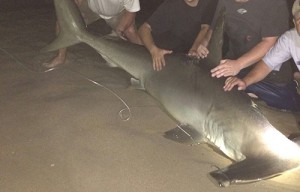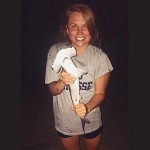
OCEAN CITY — More details emerged on Tuesday about the mature 10-foot female hammerhead caught by surf anglers early Monday morning and the frantic attempt to return at least 20 pups she birthed on the beach back into the ocean.
Just after midnight on Monday, a group, including Jess Rutherford and her brother Chad, of Harford County, along with friend Cory Yoviene of Easton, were surf fishing and hanging out on the beach at 144th Street. About a block south, another group was surf fishing at 143rd Street when they had an unusual and quite substantial catch, a roughly 10-foot female hammerhead.
Jess Rutherford said her group could hear the other group yelling and screaming about their large and unexpected catch and they ran down the beach to see what the commotion was all about. The other group had beached the hammerhead and were attempting to put the ailing shark back into the ocean. Rutherford and her group helped them attempt to put the shark back in the ocean when they made a surprise discovery.
“All of the sudden, we saw something coming out of her,” she said. “We then realized she was giving birth and my brother pulled the shark pup out of the mom and threw it into the ocean.”
Rutherford said the group that caught the hammerhead initially had left after the two groups were able to push her back into the ocean. Rutherford and her group went back to where they were fishing at 144th Street and about a half an hour later, they could see a large shape rolling in the surf about a block south. They went to the area to find the large female great hammerhead had beached herself again and when they tried to push her back in, they realized she was birthing several pups.
“We tried to push her back, but she just kept having babies,” she said. “It was pretty amazing. We were finding pups all over the shore and we were running up and down the beach and collecting them and getting them back into the ocean as fast as we could.”
Rutherford estimated there was a dozen or so pups initially that were washing around near the shoreline. She said her brother, Chad, and his friend, Cory Yoviene, pushed on the female shark’s belly and another 10 or so pups came out.
“We were frantically trying to put them back into the ocean as fast as we could, but they kept washing back up onto the beach,” she said. “Finally, we started wading into the ocean further so we could get throw them out behind the breakers because the surf was pretty rough that night. Once we were getting them behind the breakers, they stopped washing back up and we didn’t see them anymore.”
Meanwhile, the female hammerhead appeared to be succumbing to the stress of being beached and giving birth. Rutherford said the trio

“We tried to push her back, but she just kept having babies. It was pretty amazing,” said witness Jess Rutherford, pictured with one of the pups before putting it in the ocean.
attempted to drag her by the tail back into the ocean in the hopes she would revive and swim away. She said they called 911 and were told to leave the shark and let nature take its course. The Ocean City Police Department was contacted around 12:50 a.m. but by the time officers arrived on the beach, the hammerhead had perished. The Maryland Natural Resources Police confirmed they were contacted and passed the information along to the National Aquarium’s marine animal rescue program. When reached for comment, National Aquarium officials said they were contacted to consult on how to handle the beached shark, but did not respond in a rescue capacity after learning the hammerhead was already deceased.
The mature hammerhead later on Monday morning washed up on the beach in neighboring Fenwick Island and was discovered by early morning walkers who reported it to Fenwick Island officials. The shark was later reportedly dragged to the dune line by public works officials and buried, which is the normal protocol. A few years back, a large humpback beached itself in Fenwick and the deceased creature was buried on the beach as well.
National Aquarium’s Fisheries Research Specialist Alan Henningsen told The Dispatch on Tuesday it was not unusual for a hammerhead to be in close to shore at this time of year in the mid-Atlantic region.
“Hammerheads are actually very delicate and they have to continually swim to survive,” he said. “They only come up to this area in the summer time, so this would be the right time for her to be here and the right time for her to be giving birth.”
Henningsen said the mature female hammerhead would likely have been in the area close to shore to birth her pups.
“They do give birth close to shore,” he said. “They generally come in close to shore to give birth to their young because it’s a safer habitat for the pups away from other sharks and other predators.”
Rutherford estimated the total number of pups her group helped birth and get back into the water at around 20 to 22. Henningsen said that would be an accurate number and that a typical hammerhead brood numbers from as low as 13-15 and as high as 50. He said the hammerhead pups are generally about two feet long, which is consistent with the pictures of the young sharks Rutherford and her group took.
In terms of the future for the young hammerhead pups, Henningsen said a fairly large portion will likely make it, despite losing their mother.
“The minute they are birthed, they are on their own,” he said. “With sharks, there is no parental care whatsoever. The good thing is, because they were quickly put back into the water, the young sharks stand a much better chance of making it. In longer terms, their chance of survival during the first year of life is about 50-50 at best because of predation and other factors.”
Without knowing the all of the details, Henningsen said it was possible the mature female hammerhead came in close to shore to birth the pups when she was hooked by the shore fishermen. He said the stress of getting caught and beached could have triggered the birth of the pups.
“When they’re stressed, they will often abort their young even if they aren’t to term,” he said. “From what we know about this situation, it appears they were at term or close to term based on the size of the pups.”

